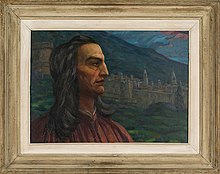| Marko Murat | |
|---|---|
 | |
| Born | Marko Murat (1864-12-30)30 December 1864 Šipanska Luka near Dubrovnik, Kingdom of Dalmatia, Austrian Empire |
| Died | 14 October 1944(1944-10-14) (aged 79) Dubrovnik, FS Croatia, DF Yugoslavia |
| Known for | Painter |
Marko Murat (Serbian Cyrillic: Марко Мурат; December 30, 1864 – October 14, 1944) was a Serbian painter from Dubrovnik who spent 20 years of his life in Belgrade, becoming a leading member of the Serbian and Yugoslav art scene at the time, before returning to his home town where he made a substantial mark in art conservation.
Life and work


Murat was born in Šipanska Luka near Dubrovnik in a Catholic family, as his uncle Vice Palunko was a noted priest and assistant bishop, and his older brother Andro Murat also became a priest. After finishing primary school in Dubrovnik in 1883, Marko Murat attended the seminary in Zadar. In 1886, he submitted a drawing to Vijenac which was noticed by Baron Lujo Vranyczany, who financed a scholarship for him to study at the Munich Art Academy. After graduation in 1893, he went to Rome and Paris.
In 1894 he moved to Belgrade, where he finally settled in 1898, employed at the Second Belgrade Gymnasium. In the year 1900, Marko Murat was a representative of Serbia at the 1900 World's Fair in Paris, where he won the bronze card for his artwork - The Arrival of Tzar Dushan of Serbia to Dubrovnik. In 1905 he was one of the founders of the Art&Craft school, the predecessors to the Academy of Fine Arts, Belgrade. Between 1904 and 1906, he was also a drawing teacher of Royal Prince Aleksandar Karađorđević of Serbia. His works were also exhibited at the 1911 World's Fair in Rome.
Murat was a proponent of Yugoslavism who wrote in his autobiography about Serb and Croat tribes of the Yugoslav nation.
He exhibited his artworks as a part of Kingdom of Serbia's pavilion at International Exhibition of Art of 1911.
At the outbreak of World War I, he was in Dubrovnik, where Austrian authorities arrested him and held him in Hungary until May 1916. After the war, Marko Murat had a major role as an art conservator in Dubrovnik, from 1919 to 1932.
In 1920 he became an honorary member of Serbian Academy of Sciences and Arts, and from 1940 he was a regular member.
In a personal correspondence with author and critic dr. Milan Šević in 1932, Murat complained that Orthodox Serbs are not acknowledging the Catholic Serb community on the basis of their faith.
Marko Murat was one of the first impressionists in the South Slavic region. Landscapes, portraits and historical compositions were his trademark. His works were displayed at almost every relevant exhibition in Yugoslavia and abroad, in Sofia, Munich, Paris, Rome, Vienna and London.
He died in Dubrovnik. The manuscript of his unfinished autobiography was lost after his death and found only recently; it presents a rare description of everyday life in Dubrovnik in the 1860s and 1870s. It was published in 2007 in the Croatian literary magazine Kolo.
References
- Nikola Tolja, Dubrovacki Srbi katolici - istine i zablude, Dubrovnik 2012
- "Marko Murat, srpski slikar, vitez akademije". Magazin Restart (in Serbian). Archived from the original on 2019-04-26. Retrieved 2019-02-07.
- ^ Ivan Viđen; Marko Murat (Summer 2007). "Muratova (auto)biografska uzgrednica / Sjećanja i misli". Kolo (in Croatian) (2). Matica hrvatska. ISSN 1331-0992. Archived from the original on 2010-08-09. Retrieved 2013-02-05.
- Elezović, Zvezdana (2009). "Kosovske teme paviljona Kraljevine Srbije na međunarodnoj izložbi u Rimu 1911. godine". Baština. 27.
- Biography at the Serbian Academy of Sciences and Arts site Archived 2011-07-27 at the Wayback Machine (in Serbian)
- Bozic, Sofija (2014-01-01). "Umetnost, politika, svakodnevica - tematski okviri prijateljstva Marka Murata i Milana Sevica". Prilozi za književnost, jezik, istoriju i folklor (80): 203–217. doi:10.2298/PKJIF1480203B.
...Ove tvoje poslednje reklo bi se da nisi primio moju gde sam Ti doneo jednu istinitu priču o Zmaju kad ono bijaše u Dubr. o otkrivanju spomenika Dživu Gunduliću. Pitao Zmaj jednog mladog dubrovačkog majstora da mu pokaže gde je srpska crkva. Mladić odgovori: "Koja?" Zmaj: "Srpska". Mladić: "Koja? Ovdi su u nas sve srpske. Koju mislite?" Zmaj: "Pravoslavnu". Mladić: "E! tako recite. Pravoslavna vam je она онамо". I Zmaj je pohvalio našega meštra koji mu je dao dobru lekciju. ― Ali sve zaludu, Milane moj! Ovi naši pravoslavci (koji ne vjeruju ništa, ateiste) zbog vere ne priznaju nas. Nismo im pravi. Ne veruju nikome. Ni vama šojkama. Valjda im niste dovoljno pravoslavni!! Jer su oni jako skrupolozni in re fidei et morum. Et morum, Milane moj! E se non ridi ― piange piuttosto. Zato nam ide sve ovako manjifiko. Hoćemo mi našu specijalnu kulturu! Sve su drugo švabe kelerabe etcetc!
External links
- Short biography (in Serbian)
- 1864 births
- 1944 deaths
- 20th-century Serbian people
- Serb-Catholic movement in Dubrovnik
- Academy of Fine Arts, Munich alumni
- 19th-century Serbian painters
- Serbian male painters
- 20th-century Serbian painters
- People from the Kingdom of Dalmatia
- 19th-century Serbian male artists
- 20th-century Serbian male artists
- Emigrants from Austria-Hungary to Serbia
- People from the Kingdom of Serbia